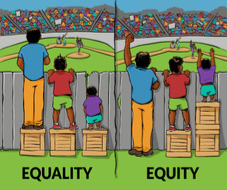Diversity, Equity and Inclusion
In November 2022 Newsletter
From AAUW.org Diversity Toolkit
Dealing with diversity can be daunting. It will help to keep in mind the Seven Underlying Principles of Diversity:
1. Diversity is an inside job, meaning that diversity is not about “them.” Rather, it is about each person coming to terms with his or her attitudes, beliefs and experiences about others and gaining comfort with difference.
2. Diversity goes beyond race and gender. The diversity tent is big enough to include everyone — young and old, homeless and affluent, immigrant and native, white and black, rural and urban, gang member and corporate professional.
3. No one is the target of blame for current or past inequities. All human beings have been socialized to behave in certain ways, and all of us are at times both perpetrators and victims of discrimination and stereotypes. The idea is to move forward in creating more opportunities.
4. Human beings are ethnocentric, seeing the world through their own narrow view and judging the world by their familiar yardstick. This is not bad in itself, but it can be a source of conflict if we do not accommodate and value other ways of being.
5. The human species resists change. This makes the constant adaptation required by diversity difficult for people already overwhelmed by staggering transitions in today’s communities and organizations.
6. Human beings find comfort in likeness. We have a tendency to seek the company of those most similar to us in a variety of ways… age, gender and ethnicity being just several of many.
7. It is difficult for people to share power. History shows that we rarely do it voluntarily. Understanding this past can help clarify why there is sometimes a backlash associated with diversity efforts from people who believe they will lose in this experience.
All of these truisms about the human species do not make people mean-spirited or cruel. It just makes us human. Never- the less, these realities make dealing with diversity a challenge.
The beauty of diversity — and the thing that makes it so powerful — is learning to appreciate it and creating an environment where it can grow and thrive. Diversity can be a great source of strength. Our aim is to create an environment where we can explore our differences in a safe and respectful way that helps each person understand their value and celebrates what diversity brings to AAUW.
Any member that is interested in serving on the La Crosse Branch of the Diversity, Equity and Inclusion committee, please contact June Reinert:
reinert.june@eagle.uwlax.edu or 608-881-0456.
In September Newsletter
Diversity, Equity and Inclusion
by June Reinert, DE&I La Crosse Branch Coordinator
Allyship
Definition of allyship:
1: the state or condition of being an ally: supportive association with another person or group. “An active, consistent, and arduous practice of unlearning and re-evaluating, in which a person in a position of privilege and power seeks to operate in solidarity with a marginalized group.”
Anyone can be an ally, but it’s not a passive role. It means speaking up and taking action not just claiming the title. Mistakes are inevitable, but being open to listening, learning, and doing better is an important part of allyship.
Listening is a vital skill for an ally. Additionally, examining our own perspectives and prejudices is also important to allyship. Everyone has biases. Learning about our own can help to mitigate their harmful impacts and can be a step towards unlearning actions that may harm others.
Speaking up might look different depending on the situation, but ideally it also includes amplifying the voices of others who are being oppressed. You are not an ally because you know best; you are an ally because you have privilege, and you are using that privilege to amplify the messages of others who are marginalized.
Privilege
Definition of privilege
1: a right or immunity granted as a peculiar benefit, ad- vantage, or favor. The notion of privilege is not new; it has been around for many decades. It seems that these days, because we’ve gained some ground in terms of equality, the notion of privilege is no longer applicable. But, in fact, it is.
The sense of privilege can also be tied to any aspect of diversity. Other types of privilege may be for straight individuals, men versus other genders, those who belong to a certain religious group, and/or members of a given political party. Examples of these types of privilege include only allowing heterosexual couples to marry and medical care differences and laws founded on one religion.
If you are in a privileged group, it is possible to use your privilege to help others by becoming an ally. Most importantly, be mindful of your actions. You may not mean to speak over others, particularly those you want to support. But, if you speak for them instead of taking their lead, you may cause more damage than good.
Any member that is interested in serving on the La Crosse Branch of the Diversity, Equity and Inclusion committee, please contact June Reinert: reinert.june@eagle.uwlax.edu or 608-881-0456.
Intersectionality and Unconscious Bias
by June Reinert, DE&I La Crosse Branch Coordinator
When discussing issues of diversity, equity and inclusion, it is important to understand the nuances of the language we use.
Intersectionality
1: the complex, cumulative way in which the effects of multiple forms of discrimination (such as racism, sexism, and classism) combine, overlap, or intersect especially in the experiences of marginalized individuals or groups
Legal scholar Kimberlé Crenshaw coined the term intersectionality in her work Mapping the Margins. She noted that scholars often look at outcomes for women or for African Americans, but never look at what happens to African American women whose lives are impacted by the ways these multiple sources of oppression interact. Understanding intersectionality gives us a way of understanding the cumulative effect of discrimination and oppression on people. That’s not that one person’s oppression is greater than another’s; it’s a way of recognizing that our experiences may not be the same because inequality is a complex phenomenon.
Here’s an example familiar to AAUW members: Pay equity. We know that men and women are paid unequally for equal work: on average, women make 82¢ for every dollar that a white man makes. But did you know that moms make 70¢ on that same dollar? Or that Latinas make just 55¢? These are just a few examples of intersectionality and how parental status, or ethnicity intersect with gender to impact pay equity.
Definition of unconscious
1 : not marked by conscious thought, sensation, or feeling
2 : not knowing or perceiving : not aware
3 : not consciously held or deliberately planned or carried out
Definition of bias
1 : an inclination of temperament or outlook especially : a personal and sometimes unreasoned judgment : prejudice
We all know what overt biases are, but we all have unconscious biases, too. These are biases that might be inconsistent with our values, that we would never knowingly act on and that we weren’t even aware we had. And having them doesn’t make us racist or sexist or homophobic, etc… At any given, moment we are bombarded with lots of information, but our brains can only process a fraction of it at once. To help us try and make sense of the world around us, our brain uses short cuts. Those short cuts are shaped and informed by our experiences. But, because sometimes the things we need to make sense of are unfamiliar, bias can enter the picture.
For example, here is an image, what do you see? Triangles, circles? This is the Kanizsa Triangle. Most people see a solid white triangle pointing upwards, an inverted triangle pointing downwards, and a set of black discs. But the fact is, none of these shapes are present in the figure; this image is of “pac-men” and V’s, not triangles and circles. This is an example of our unconscious mind using familiar information to try and make sense of what it sees, because in the absence of complete information, our mind needed to rely on something to help us figure it out. So, what can you do?
1. Self-awareness is the first step
2. Create safe spaces to have open discussions about the biases you have
3. Increase your contact with people who are dissimilar
4. Set realistic expectations
We’re not going to be able to change our unconscious mind over night, but we will be able to make progress. Only when we confront our biases are we able to truly recognize the value diversity brings to an organization like AAUW. It’s important for our continued growth and sustainability as an organization to make a concerted effort to be inclusive and create spaces where everyone feels welcome.
“Dealing with Diversity can be Daunting”
by June Reinert, DE&I La Crosse Branch Coordinator
April Newsletter
Key Terms & Concepts
When discussing issues of diversity, equity and inclusion, it is important to understand the nuances of the language we use.
Definition of diversity
1: the condition of having or being composed of differing elements : variety especially : the inclusion of different types of people (such as people of different races or cultures) in a group or organization programs intended to promote diversity in schools.
2: an instance of being composed of differing elements or qualities : an instance of being diverse a diversity of opinion.
Variety. That’s what diversity means in essence. But it also means that recognizing what makes us different and unique is important and, without taking diversity into consideration, we run the risk of excluding some individual.
Definition of Inclusion
1 : the act of including : the state of being included.
2 : the act or practice of including and accommodating people who have historically been excluded (as because of their race, gender, sexuality or ability).
Diversity vs. Inclusion
Diversity refers to characteristics, the dimensions that make each of us unique. Inclusion entails behaviors and actions that make us feel welcomed or not. An environment that creates a sense of belonging, where everyone feels welcomed and included, is essential for the success of diversity efforts.
To be truly inclusive, we often must change the culture that in environments where people feel supported, welcomed, respected, and valued are actually more productive; everyone feels a greater connection to the organization’s mission.
As diversity advocate Verna Myers once said, “Diversity is being invited to the party, and inclusion is being asked to dance.” If you don’t have both, neither works.
Inclusion vs. Belonging
So, if diversity means the characteristics that make us unique, and inclusion refers to behaviors and actions, then what is belonging? Belonging is feeling like you are a part of something, that you actually you matter. AAUW needs all of these things together — diversity, inclusion, and belonging — for our branches to continue to grow and thrive.
Definition of equity
1a : justice according to natural law or right specifically : freedom from bias or favoritism.
1b : something that is equitable.
Every AAUW member should understand what we mean by equity. After all, we are the nation’s premier organization fighting for gender equity.
Equity vs. Equality
Although these two words have the same root, they don’t mean the same thing. They are often used interchangeably, even though they differ in meaning. Equality means everyone gets the same access to — or amount of — something. Equity, by contrast, is about everyone having equal access to what they need to be successful. And those needs can be quite different.

